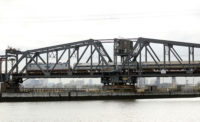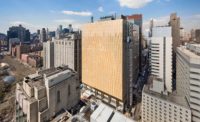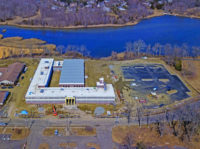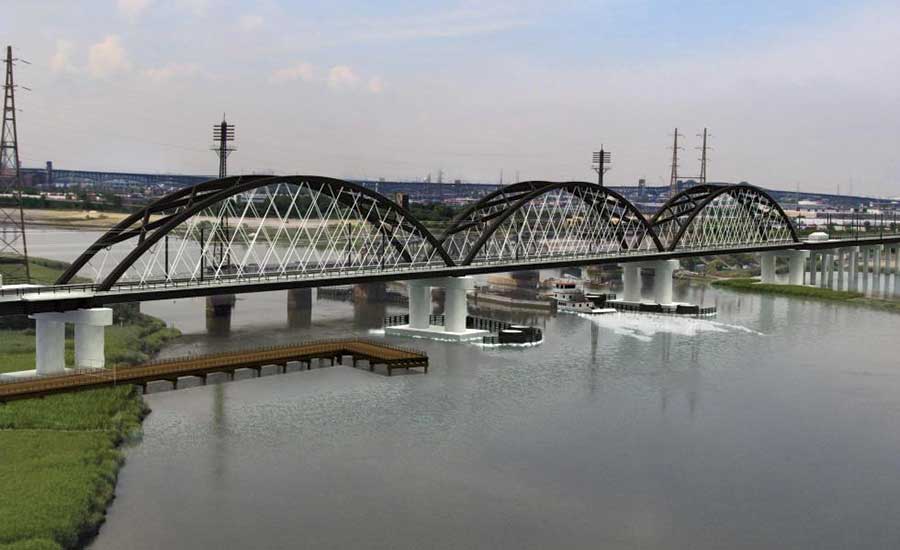NY-NJ Gateway Project: Critical Fixes, Big Builds

Outdated Trains headed in and out of Manhattan use infrastructure built more than a century ago. The Hudson River tunnel also was damaged during Superstorm Sandy in 2012. Photo courtesy of Amtrak Gateway project

New Link The Portal Bridge North replacement span in New Jersey will have a 53-ft river clearance on a fixed span, unlike the current 107-year-old swing span bridge. Image courtesy of Amtrak Gateway project

Ambitious Plan Multifaceted Gateway program is estimated to cost $30 billion. The Trump administration has yet to commit to the federal share pledged in 2015. Map by ENO Center for Transportation Studies, Rutgers University

Bottleneck Swing span bridge across the Hackensack River, which opened in 1910, often gets stuck or misaligns after opening to allow river traffic through. Its replacement will have a 53-ft river clearance. Photo courtesy of Amtrak Gateway project

Wear and Tear Deteriorating concrete in the 110-year-old Hudson River tubes, further damaged by saltwater intrusion during hurricane Sandy, will be replaced. Photo courtesy of Amtrak Gateway project

Alignment In Manhattan, Gateway project tracks will weave under the new Hudson Yards complex and be encased in concrete boxes that will support skyscrapers above. Photo courtesy of Amtrak Gateway project






The nearly $30-billion Gateway program to overhaul Northeast Corridor rail lines between Newark and New York City, an array of tunnels, bridges and viaduct over wetlands has two main thrusts: rehabilitation and expansion. These objectives are deeply intertwined—the project team must build new structures in the huge effort before it can upgrade old ones.
That’s why digging two 1.4-mile, 28-ft-dia train tunnels under the Hudson River—an estimated $12.9-billion project component—isn’t just an expansion job but a lifeline to free a pair of 107-year-old tubes heavily damaged by Superstorm Sandy in 2012 and in need of a rebuild.
“You have a swing bridge in the busiest section of railroad in the country. That’s why it’s critical to move forward as fast as we can.”
– Jim Richter, Deputy Chief Engineer for Structures, Amtrak
It’s also why the new $1.5-billion, 1,200-ft-long, three-section tied-arch Portal Bridge North rail span must open before removing the existing swing structure—itself 110 years old and subject to increasingly frequent malfunctions and misalignments each time it opens to let boats chug along the Hackensack River, halting train traffic in the busy commuting and traveling corridor.
The goal of doubling the 10-mile segment’s capacity from two timeworn tracks to four modern ones may not be realized for a decade or more, but each step will improve a frail, congested rail system with no room for error, says Jim Richter, deputy chief engineer for structures at Amtrak, a lead agency on Gateway.
“If you had to shut down one of the existing tunnels during peak hours, you would go from 24 trains crossing under the river an hour to six,” he says. “And you have a swing bridge in the busiest section of railroad in the country. That’s why it’s critical to move forward as fast as we can.”
Try, Try Again
Gateway incorporates features envisioned a decade ago in the ARC program, which soon-to-leave-office New Jersey Gov. Chris Christie and other officials abandoned in 2010, claiming cost risk to the state. With its successor—that has New York and New Jersey funding half the overall budget and a groundbreaking that occurred in October for the Portal Bridge project—hopes are high that Gateway can get rolling.
“The working schedule calls for [tunnel] construction to start in early 2019, assuming the funding is there. You want to be ready to go.”
– Phil Rice, Lead Project Engineer, Gateway Trans-Hudson Partnership
Even so, the federal contribution pledged in 2015 has yet to be funded by the new Trump administration. For now, 450 New Jersey Transit and Amtrak trains using today’s infrastructure daily—and the 200,000 passenger trips they enable—are on borrowed track.
The team has put its focus toward advancing designs with grant and state funding, says Phil Rice, lead project engineer for WSP, which is partnered with AECOM and STV on the Gateway Trans-Hudson Partnership tunnel engineering team.
“The working schedule calls for [tunnel] construction to start in the early part of 2019, assuming the funding is there,” he says. “You want to be ready to go.”
Solutions and Questions
Gateway is a sweeping set of fixes across 10 miles: replacing the Portal and Sawtooth bridges; expanding mainline tracks from two to four; creating a loop at Secaucus Junction to give northern routes a direct ride into Manhattan; building the Hudson tunnels; expanding Manhattan’s Pennsylvania Station—and more.
The tunnels and Portal Bridge are critical; delays or closures for either can cripple traffic across the Northeast.
Design work began five years ago on Portal Bridge North, the first of two planned spans with 53-ft clearances. It now is at 100%, while the Hudson tunnel design that started two years ago should be at 30% by next spring, says Rice. “We’re also looking at how to split up [tunnel] bid packages … to minimize the number of interfaces to manage between contracts,” he says.
One Gateway funding source may be institutional investors such as Blackstone Group and private equity firms, which have acquired an appetite for infrastructure deals.
Amtrak, New Jersey Transit, the Port Authority of New York and New Jersey and other transportation managing agencies have combined forces under the Gateway Development Corp., a nonprofit overseer of the larger program.
Securing funding is a priority for the entity, which issued a request for ideas from the industry on financing options, Richter says. One funding source may be institutional investors and private equity firms—which have acquired an appetite for infrastructure deals—with the Hudson tunnels discussed during a recent Blackstone Group earnings call as a potential investment target.
Even with overall funding unclear, the Portal Bridge team secured a federal matching grant for the $20-million project that started last month, says Steven Santoro, New Jersey Transit executive director. “That’s what this early action does—move the project forward,” he says.
Under River, Over River
The Hudson tunnels effort doesn’t just dive under the riverbed. The work starts east of Secaucus with new viaduct and structures to take tracks —roughly aligned with the two existing lines—across the Meadowlands and over or under roadways and freight lines.
That section will include 3,100 ft of viaduct and an overhead highway bridge carrying U.S. Routes 1 and 9, Rice says.
The tracks then reach Bergen Hill, where tunnel boring machines (TBMs) will chomp through rock at depths of up to 270 ft for nearly one mile through the Palisades cliffs along the Hudson River, Richter points out.
Those 25-ft-dia tunnels will run to the 90-ft-deep Hoboken shaft that will serve as the launch point to dig below the riverbed—first through 1,900 ft of full face sandstone, then through mixed or soft ground to a 100-ft-deep Manhattan shaft. Both shafts will later house tunnel ventilation buildings.
In Manhattan, the alignment will weave under Hudson River Park—several avenues and the Hudson Yards residential, office and retail development built over railyards west of Penn Station—with tracks encased in concrete boxes that double as foundations for skyscrapers above, Richter says.
Tough Terrain
A big hurdle is aligning the new tubes with shallow exit points in Manhattan, barely 40 ft under 12th Avenue, where abandoned piles from the old elevated West Side Highway and sewer lines also lurk as obstacles, Rice says.
“We’re 60 to 70 ft down when we start [in Hoboken] and then we’re rising as we go under the river, so at the New York end we’re as little as 10 to 15 ft [below the riverbed],” Rice explains. “There’s soft ground at that depth, so we’re looking at earth pressure balance machines as the boring technology for efficient tunneling as we transition from rock to soil.”
Shallower areas may also require stabilization, with the team exploring jet grouting and temporary sheet pile cofferdams to create more solid ground for TBMs to bore through, Rice says.
Similarly, drilling through a late 19th-century bulkhead—a massive riprap stone and timber pile structure, topped with a masonry seawall, off the Manhattan shoreline—likely will require ground freezing, grouting or a short tunnel mined from the New York side, he says.
The new Portal Bridge entails other challenges: shallow wetlands and a mandate for construction to not disrupt current swing bridge operations, says Kerry Donovan, chief of construction management at New Jersey Transit.
The current 534-day contract with PKF-Mark III, Newtown, Pa., is installing finger piers, roadways, platforms, fiber optic cable, retaining walls and other structures to prepare for the eventual main contract, he says.
“Drilling in a swamp isn’t that easy,” Donovan says. “We have platforms out there [to help] contractors to get the equipment in.”
The team already took nearly 700 borings and drove test piles into the marshlands, according to Donovan. The design calls for building the main bridge’s structure off site except for its tie-ins, he says.
The main contract will offer discretion on getting the structure to the site—by river, temporary roadway or other means, Donovan adds. “The contractor will determine the most cost-effective way to do the installation,” he says.
Mitigation and Rehabilitation
The Gateway designs also address state and federal environmental standards, with the Portal Bridge having secured all permits and outlined mitigation plans and the Hudson tunnel project on target to finish a supplemental environmental impact statement (EIS) on a two-year schedule—twice as fast as normal—next April.
“I don’t know anyone who’s done an EIS that fast and big in an urban environment,” Richter says.
The tunnel team held draft EIS public comment sessions this summer, where groups such as NY/NJ Baykeeper stressed the need for mitigation efforts. The project team has been responsive, says Michele Langa, the nonprofit’s staff attorney.
“We know this project is necessary for the region,” she says. “We want to make sure we mitigate where possible to minimize harm to the Meadowlands and any shoreline disturbance on the New York side. It’s not new to [the project team] what the issues are.”
The efforts may include addressing construction impact through mitigation of land within the same watershed, Langa says, with measures such as replantings, restoring contaminated water and soil, adding fresh soil or clean fill and increasing permeability in one wetlands section to balance loss in another.
Next Horizon
Gateway’s next horizon entails projects to rehabilitate aging infrastructure or add capacity. A big piece will be rebuilding the existing Hudson River tubes, which Sandy flooded with millions of gallons of seawater—leaving salts and chlorides that have eroded concrete walls protecting high voltage cables, Rice says.
Another effort will be expanding Penn Station, likely adding four platforms and eight tracks—work that isn’t part of the new Moynihan Station train hall project, Richter says.
In addition, the Portal Bridge South, a virtual twin to the northern structure, is halfway through design, Santoro says, and would enable the jump from two to four mainline tracks. “Maintaining the existing level of train traffic in a reliable manner is what Phase 1 of the Gateway program is all about,” he says. “Phase 2 is where we increase capacity.”










